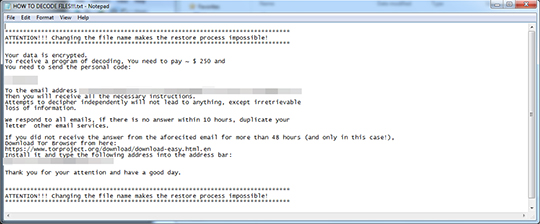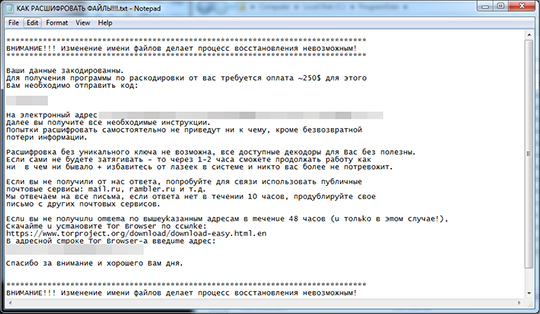RANSOM_CRYPDNC.A
Ransom.DoNotChange(Malwarebytes)
Windows


Threat Type: Ransomware
Destructiveness: No
Encrypted: No
In the wild: Yes
OVERVIEW
Dropped by other malware, Downloaded from the Internet
This Ransomware arrives on a system as a file dropped by other malware or as a file downloaded unknowingly by users when visiting malicious sites.
TECHNICAL DETAILS
712,704 bytes
EXE
Yes
30 Mar 2017
Drops files, Encrypts files
Arrival Details
This Ransomware arrives on a system as a file dropped by other malware or as a file downloaded unknowingly by users when visiting malicious sites.
Installation
This Ransomware drops the following files:
- %All Users Profile%\A.txt - list of encrypted files
- %All Users Profile%\A2.txt - list of encrypted files
- {folder of encrypted files}\HOW TO DECODE FILES!!!.txt - ransom note
- {folder of encrypted files}\КАК РАСШИФРОВАТЬ ФАЙЛЫ!!! - ransom note in russian language
- %User Temp%\~.bat - delete itself and shutdown the infected machine after 1 minute
(Note: %All Users Profile% is the All Users folder, where it usually is C:\Documents and Settings\All Users on Windows 2000, Windows Server 2003, and Windows XP (32- and 64-bit); C:\ProgramData on Windows Vista (32- and 64-bit), Windows 7 (32- and 64-bit), Windows 8 (32- and 64-bit), Windows 8.1 (32- and 64-bit), Windows Server 2008, and Windows Server 2012.. %User Temp% is the user's temporary folder, where it usually is C:\Documents and Settings\{user name}\Local Settings\Temp on Windows 2000, Windows Server 2003, and Windows XP (32- and 64-bit); C:\Users\{user name}\AppData\Local\Temp on Windows Vista (32- and 64-bit), Windows 7 (32- and 64-bit), Windows 8 (32- and 64-bit), Windows 8.1 (32- and 64-bit), Windows Server 2008, and Windows Server 2012.)
Other Details
This Ransomware renames encrypted files using the following names:
- {original filename and extension}.id-7ES642406.cry
It does the following:
- It executes the following commands:
- cmd.exe /c %System%\icacls.exe "c:\System Volume Information" /grant {username}:F
- cmd.exe /c %System%\icacls.exe "c:\System Volume Information" /remove {username}
- cmd.exe /c %System%\icacls.exe "d:\System Volume Information" /grant {username}:F
- cmd.exe /c %System%\icacls.exe "d:\System Volume Information" /remove {username}
- It also encrypts files with file size greater than 1,800,000 bytes and does not have any of the following extensions:
- .cry
- .dll
- .iso
- .tmp
- .ypt
- It encrypts files with file size greater than 9000 bytes and has any of the following extensions:
- .1cd
- .3dp
- .3gp
- .7z
- .abk
- .abs
- .accdb
- .as
- .ate
- .avi
- .bac
- .backu
- .bak
- .bin
- .bkc
- .bkf
- .bkp
- .bls
- .bpn
- .c
- .cab
- .cbk
- .cbu
- .cdd
- .cdr
- .cdw
- .cdx
- .cer
- .cf
- .cfu
- .cgm
- .ck9
- .cmx
- .cpp
- .cpt
- .cs
- .csr
- .csv
- .dat
- .db
- .db2
- .db3
- .dba
- .dbc
- .dbf
- .dbk
- .dbs
- .dbt
- .dbv
- .dbx
- .dcb
- .dd
- .ddl
- .dds
- .df1
- .dgn
- .dmo
- .doc
- .docm
- .docx
- .dp1
- .dt
- .dwg
- .dxf
- .dxl
- .eap
- .eco
- .edb
- .emd
- .eml
- .epf
- .eps
- .eql
- .erf
- .ert
- .ext
- .fbf
- .fbu
- .fcd
- .fh
- .flb
- .flkb
- .frf
- .frm
- .frm
- .frx
- .gdb
- .gpx
- .gzip
- .hdr
- .htm
- .html
- .igs
- .java
- .jpeg
- .jpg
- .jse
- .json
- .jsp
- .key
- .ldf
- .mac
- .md
- .mdb
- .mdf
- .mdx
- .mft
- .mp4
- .mpeg
- .msf
- .msg
- .mxl
- .myd
- .myi
- .nam
- .nb7
- .nbd
- .nbk
- .nbs
- .ncb
- .nch
- .ndoc
- .nofiles
- .npf
- .ns2
- .ns3
- .ns4
- .nyf
- .obkp
- .ods
- .odt
- .old
- .one
- .ora
- .pan
- .pas
- .pdb
- .pdm
- .pdn
- .phm
- .pl
- .png
- .pps
- .ppsm
- .ppt
- .pptm
- .pptx
- .ps
- .psd
- .pst
- .py
- .rar
- .ref
- .reg
- .rsd
- .rtf
- .sai
- .sbb
- .sbf
- .sdb
- .sdf
- .sqb
- .sql
- .sqlite
- .sqlite3
- .sqlitedb
- .svg
- .tar
- .tbb
- .tbn
- .tdt
- .te
- .tib
- .txt
- .uci
- .udb
- .usr
- .vbe
- .vbp
- .vbs
- .vbx
- .vhd
- .vmdk
- .vrp
- .xds
- .xld
- .xls
- .xlsm
- .xlsx
- .xml
- .zip
- It executes the following commands to stop services:
- net stop "MSSQLSERVER" /y
- net stop "MSSQL$SQL" /y
- net stop "MSSQL$SQLEXPRESS" /y
- net stop "postgresql-x64-9.6" /y
- net stop "Schedule" /y
- net stop "RKeeperMidServer" /y
- net stop "RKeeperRepServer" /y
- net stop "SDBSERV" /y
- net stop "SQLWriter" /y
- net stop "TeamViewer" /y
- net stop "hMailServer" /y
- net stop "MySQL" /y
- net stop "MSSQL$S15292784" /y
- net stop "SQLBrowser" /y
- net stop "FileZilla Server" /y
- net stop "RServer3" /y
- net stop "afcdpsrv" /y
- net stop "syncagentsrv" /y
- net stop "C__UCS_CARDSERV_CARDSERV" /y
- net stop "Sdbserv 192.168.0.18" /y
- net stop "tvnserver" /y
- net stop "SrvSgr030" /y
- net stop "GbpSv" /y
- net stop "uvnc_service" /y
- net stop "MSSQL$MEGASUL" /y
- net stop "fbguard" /y
- net stop "fbserver" /y
- net stop "D_RK6CARDSERV_CARDSERV" /y
- net stop "acrSch2Svr" /y
- net stop "acrSch2Svr" /y
(Note: %System% is the Windows system folder, where it usually is C:\Windows\System32 on all Windows operating system versions.)
NOTES:
The ransom notes contains the following:


SOLUTION
9.850
13.308.06
30 Mar 2017
13.309.00
31 Mar 2017
Step 1
Before doing any scans, Windows XP, Windows Vista, and Windows 7 users must disable System Restore to allow full scanning of their computers.
Step 2
Note that not all files, folders, and registry keys and entries are installed on your computer during this malware's/spyware's/grayware's execution. This may be due to incomplete installation or other operating system conditions. If you do not find the same files/folders/registry information, please proceed to the next step.
Step 3
Restart in Safe Mode
Step 4
Search and delete this file
- %All Users Profile%\A.txt
- %All Users Profile%\A2.txt
- {folder of encrypted files}\HOW TO DECODE FILES!!!.txt
- {folder of encrypted files}\КАК РАСШИФРОВАТЬ ФАЙЛЫ!!!
- %User Temp%\~.bat
Step 5
Restart in normal mode and scan your computer with your Trend Micro product for files detected as RANSOM_CRYPDNC.A. If the detected files have already been cleaned, deleted, or quarantined by your Trend Micro product, no further step is required. You may opt to simply delete the quarantined files. Please check this Knowledge Base page for more information.
Step 6
Restore encrypted files from backup.
Did this description help? Tell us how we did.

